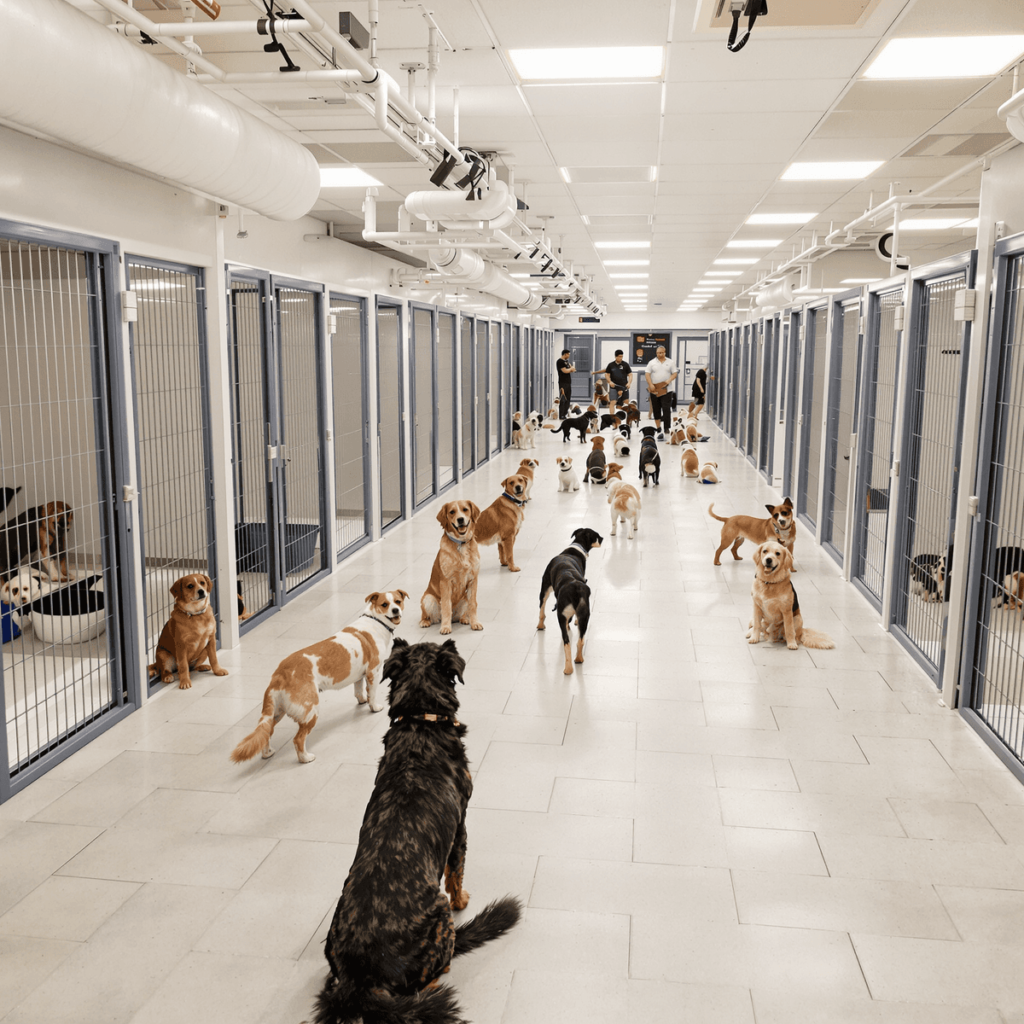What is a boarding facility for Your Furry dogs?

Understanding Boarding Facilities for Dogs
A Dog Boarding Facilities for dogs serves as a temporary home where your furry friend stays during your absence. Think of it as a hotel designed specifically for dogs, providing essential care, attention, and a safe environment when you’re away on vacation, business trips, or other commitments.
These specialized facilities offer a range of services to ensure your dog’s comfort and well-being:
- Basic Care Services: Comfortable sleeping quarters, regular feeding schedules, fresh water availability, bathroom breaks, and exercise time.
- Additional Services: Professional grooming, training sessions, health monitoring, specialized dietary management, and individual playtime.
Many boarding facilities create structured daily routines that mirror your dog’s home schedule. Your pet receives attention from trained staff members who understand canine behavior and can respond to their unique needs.
The primary goal of a boarding facility extends beyond simple pet-sitting. These establishments aim to create a stress-free environment where dogs can:
- Maintain their regular routines
- Enjoy social interactions
- Receive proper exercise
- Stay mentally stimulated
- Get professional care and supervision
When you choose a quality boarding facility, you’re selecting a partner in your dog’s care who will maintain their physical health and emotional well-being during your time apart.
Exploring Different Types of Boarding Facilities
Your dog’s boarding experience can vary significantly based on the facility type you choose. Let’s explore the main options available:
1. Traditional Kennels
Traditional kennels are basic boarding facilities that provide essential care for dogs. Here are some key features:
- Basic indoor/outdoor runs
- Standard feeding and exercise schedules
- Shared play areas
- Essential care services
- Budget-friendly pricing
- Simple sleeping quarters
2. Luxury Pet Hotels
Luxury pet hotels offer a high-end boarding experience with various amenities and services. Here are some features you can expect:
- Private suites with comfortable bedding
- Webcam monitoring systems
- Climate-controlled environments
- Themed rooms and specialized décor
- Swimming pools and spa services
- Gourmet meal options
3. Tailored Services
Many facilities offer customizable packages to match your dog’s needs:
- Training sessions during their stay
- Grooming services from professional groomers
- One-on-one playtime with dedicated staff
- Special dietary accommodations
- Enrichment activities like puzzle toys
- Specialized exercise programs
Why Choosing the Right Boarding Facility Matters for Your Dog’s Happiness and Well-Being
Your dog’s emotional and physical well-being depends on finding a boarding facility that prioritizes professional care and socialization. A carefully selected facility can create positive experiences that shape your dog’s behavior and attitude toward future stays.
The Benefits of Professional Care
Look for these advantages when considering a boarding facility:
- Trained staff who understand canine body language
- Regular monitoring of eating habits and health status
- Structured daily routines that reduce anxiety
- Quick response to emergencies or health concerns
The Importance of Socialization
The social aspects of boarding facilities are crucial for your dog’s development and happiness. Dogs are naturally pack animals, and positive interactions with other dogs can:
- Build confidence in shy or anxious dogs
- Improve social skills through supervised play
- Reduce boredom and separation anxiety
- Provide mental stimulation through new experiences
Signs of Quality Professional Care
Look for these indicators of professional care when choosing a boarding facility:
- Staff certified in pet first aid
- Regular training updates for employees
- Clear protocols for handling emergencies
- Detailed daily reports on your dog’s activities
Creating a Balanced Environment
A facility that combines professional care with socialization opportunities creates an environment where your dog can thrive. Staff members should assess each dog’s personality and comfort level, creating appropriate playgroups based on size, energy level, and temperament. This individualized attention ensures your dog receives the right mix of social interaction and quiet time.
Factors to Consider When Selecting a Boarding Facility for Your Dog’s Stay
Selecting the right boarding facility requires careful evaluation of several critical factors:
Cleanliness Standards
- Daily sanitization of kennels and play areas
- Regular waste removal protocols
- Proper ventilation systems
- Clean bedding and food/water bowls
- Odor-free environment
2. Security Measures
- 24/7 surveillance cameras
- Secure fencing and gates
- Fire safety systems
- Emergency evacuation plans
- Individual kennel locks
3. Staff Qualifications
- Certified pet care professionals
- Training in pet first aid
- Experience handling different breeds
- Knowledge of dog behavior
- Staff-to-dog ratio
4. Exercise Options
- Indoor play areas
- Outdoor running spaces
- Structured exercise programs
- Individual walking schedules
- Group play sessions
You can assess these factors through facility tours and direct questions to staff members. Request to see their cleaning schedules, security protocols, and staff certifications. Watch how the staff interacts with the dogs in their care. The best facilities maintain transparent policies and welcome your questions about their operations.
A high-quality boarding facility demonstrates its commitment to these essential aspects through detailed documentation, visible cleanliness, and professional staff behavior. These elements create a safe, healthy environment where your dog can thrive during their stay.
Protocols and Policies That Ensure a Safe and Comfortable Experience at Boarding Facilities for Dogs
Reputable boarding facilities maintain strict protocols to safeguard your dog’s health and well-being during their stay. Here’s what you need to know about essential policies:
Vaccination Requirements
- Core vaccines (DHPP, Rabies) must be up-to-date
- Bordetella vaccination within the past 6 months
- Proof of flea and tick prevention
- Health certificates from licensed veterinarians, following the AAHA guidelines
Emergency Response Plans
- 24/7 veterinary care partnerships
- Staff trained in pet first aid
- Detailed emergency contact information
- Medical history records on file
- Evacuation procedures for natural disasters, similar to those outlined in FEMA’s emergency response plan
Feeding Arrangements
- Scheduled feeding times matching home routines
- Storage of special diet foods
- Portion control monitoring
- Fresh water available at all times
- Documentation of food allergies
- Separate feeding areas for anxious eaters
Professional facilities track these protocols through digital systems, maintaining detailed records of each pet’s requirements. Staff members receive regular training updates on implementing these policies, ensuring consistent care standards across all shifts. You’ll find clear documentation requirements and specific timelines for submitting health records before your dog’s stay.
Many facilities also incorporate daily health checks into their routines, monitoring your dog’s eating habits, behavior patterns, and physical condition throughout their stay. These checks are crucial not only for boarding facilities but also for ensuring a safe environment in case of emergencies or natural disasters.
Specialized Care and Accommodations Offered by Some Boarding Facilities to Cater to Unique Needs of Certain Dogs
Modern boarding facilities recognize that each dog comes with unique requirements. Many facilities now offer specialized services for dogs with specific medical conditions, physical limitations, or behavioral needs.
Special-Needs Accommodations Include:
- Quiet, separate areas for anxious or reactive dogs
- Temperature-controlled rooms for older pets
- Extra padding and orthopedic beds for arthritic dogs
- Ground-level access for mobility-impaired pets
- One-on-one attention for blind or deaf dogs
Medication Administration Protocols:
- Certified staff trained in medication administration
- Detailed medication logs tracking doses and timing
- Secure storage for prescription medications
- Regular health monitoring and documentation
- Direct communication lines with veterinarians
Many facilities employ staff with veterinary backgrounds to handle complex medical needs. These professionals can:
- Administer insulin injections
- Monitor blood sugar levels
- Provide wound care
- Handle post-surgery recovery care
- Manage chronic conditions
Some facilities create personalized care plans for each special–needs dog, incorporating:
- Specific feeding schedules
- Modified exercise routines
- Regular health checks
- Specialized grooming requirements
- Adapted socialization opportunities
These dedicated accommodations ensure that dogs with unique needs receive appropriate care, allowing their owners to travel with peace of mind knowing their pets’ specific requirements are met.
This level of specialized care is akin to the comprehensive care strategies outlined in the MDS 3.0 RAI Manual, which emphasizes the importance of personalized approaches in managing individual needs effectively, whether in a boarding facility or a healthcare setting.
Preparing Your Dog for a Successful Stay at a Dog Boarding Facilities: Tips from Experienced Owners and Trainers
Setting your dog up for success at a boarding facility requires careful preparation. Professional trainers recommend scheduling a test run before committing to an extended stay. This initial visit allows you to:
- Observe your dog’s comfort level in the new environment
- Meet staff members who’ll care for your pet
- Identify potential adjustment challenges
- Assess the facility’s handling of your dog’s specific needs
Essential Steps for a Smooth Transition:
- Pack familiar items from home:
- Favorite toys
- Regular bedding
- Your unwashed shirt carrying your scent
- Maintain your dog’s routine:
- Keep regular feeding schedules
- Continue exercise patterns
- Follow established bathroom breaks
Many experienced dog owners introduce their pets to boarding facilities through gradual exposure. Start with short daycare visits, then progress to overnight stays. This approach helps your dog build positive associations with the facility.
Training Tips Before Boarding:
- Practice basic commands to ensure staff can manage your dog
- Work on separation anxiety if present
- Reinforce socialization skills with other dogs
- Teach your dog to accept food and care from different people
Remember to communicate any behavioral changes you notice during test runs to the facility staff. This information helps them create a personalized care plan for your dog’s extended stay.
Peace of Mind for Owners: How Choosing the Right Dog Boarding Facilities Can Provide Reassurance While You’re Away
A quality boarding facility acts as your trusted partner in pet care, offering real-time updates and transparent communication about your dog’s daily activities. Many facilities now provide:
- Photo updates through dedicated apps
- Daily report cards detailing eating habits and activities
- Direct access to staff via messaging systems
- Live webcam feeds in common areas
The presence of qualified professionals creates a secure environment where your dog receives individualized attention. Staff members track:
- Eating patterns
- Bathroom habits
- Energy levels
- Social interactions
- Behavioral changes
A supportive setting helps maintain your dog’s emotional well-being through:
- Consistent Daily Routines: Fixed schedules for meals, walks, and playtime
- Familiar Comfort Items: Personal beds, toys, and blankets from home
- Individual Space: Quiet areas for rest and decompression
- Professional Supervision: Trained staff monitoring group interactions
Modern facilities understand the anxiety pet parents experience during separation. They implement systems to keep you connected and informed about your dog’s experience. This level of transparency allows you to enjoy your time away, knowing your furry friend is receiving attentive care in a nurturing environment.
Conclusion
A reputable boarding facility serves as your dog’s trusted home-away-from-home, offering professional care, socialization, and structured routines. Your research efforts in selecting the right facility directly impact your pet’s comfort and safety during their stay.
Key takeaways for choosing a boarding facility:
- Verify staff qualifications and facility certifications
- Inspect cleanliness standards and safety protocols
- Review vaccination requirements and health policies
- Check available amenities and exercise programs
- Read client testimonials and facility reviews
A well-researched boarding choice transforms your time away from a worry-filled experience into a confident decision, knowing your furry friend receives exceptional care in a nurturing environment. Your dog deserves nothing less than a boarding facility that treats them as their own family member.
